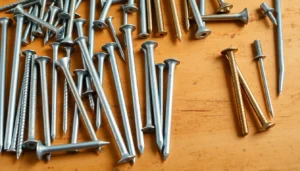When it comes to assembling furniture or tackling DIY projects, having the right hardware assembly tools can make all the difference. Imagine trying to build that sleek bookshelf with nothing but a butter knife and sheer determination. Spoiler alert: it won’t end well. The right tools not only save time but also help avoid the dreaded wobbly shelf syndrome that haunts many a homeowner.
From trusty screwdrivers to the mighty power drill, each tool plays a crucial role in transforming chaos into order. Whether you’re a seasoned pro or a weekend warrior, understanding these tools is essential. Dive into the world of hardware assembly tools, where every screw and bolt has its purpose, and discover how to elevate your assembly game. Get ready to turn your tool collection into your new best friend—because who doesn’t want a sidekick that can help them build their dreams?
Table of Contents
ToggleOverview of Hardware Assembly Tools
Hardware assembly tools play a crucial role in successful furniture assembly and DIY projects. Every tool serves a unique function, ensuring stability and efficiency during the assembly process. Screwdrivers, for example, come in various types like Phillips and flathead, catering to different screw heads. They provide precision and control, making them indispensable for assembling furniture.
Power drills significantly enhance the speed of projects. Equipped with various bits, they can quickly create holes and drive screws into materials. Because they cut down on time, power drills are often preferred by both novices and experienced builders alike.
Tape measures are essential for accurate measurements. Ensuring all pieces fit correctly relies on precise dimensions. Without accurate measurements, even the best tools may lead to imprecise or unstable constructions.
Leveling tools help prevent wobbly furniture. A level ensures surfaces remain straight and surfaces align properly. This tool becomes particularly invaluable in projects where balance is critical.
Pliers assist with gripping and twisting components. Some types, like needle-nose pliers, access tight spaces, making them ideal for small hardware. Adjustable wrenches add versatility by accommodating various nut and bolt sizes.
In addition to these tools, clamps provide stability during assembly. They secure pieces together while the adhesive cures or fasteners are applied. This ensures everything remains aligned throughout the assembly process.
Investing time in understanding the function and application of each hardware assembly tool leads to improved outcomes in projects. Familiarity with these tools boosts confidence and enhances overall DIY skills. Therefore, selecting the right tools is fundamental to meeting assembly goals effectively.
Types of Hardware Assembly Tools
Understanding the types of hardware assembly tools enhances efficiency in projects. Two main categories exist: hand tools and power tools.
Hand Tools
Hand tools play a crucial role in precise and detailed work. Screwdrivers, with their various head types, allow users to drive screws securely. Pliers provide the necessary grip for twisting and bending materials. Tape measures ensure accurate measurements, preventing mistakes during assembly. Utility knives offer versatility for cutting different materials. Each tool offers unique advantages, making them indispensable for various tasks.
Power Tools
Power tools significantly speed up the assembly process. Cordless drills simplify drilling holes and driving screws without the hassle of cords. Impact drivers deliver more torque, making them ideal for heavy-duty applications. Saws, such as circular and jigsaws, provide exact cuts for various materials. Sanders ensure smooth finishes, improving project aesthetics. Using power tools not only boosts efficiency but also reduces physical strain, enabling smoother workflows.
Essential Features to Consider
Selecting the right hardware assembly tools involves considering several essential features that impact performance and usability. Durability and ergonomics stand out as crucial factors.
Durability
Durability plays a vital role in tool selection. High-quality tools withstand wear and tear, providing long-term reliability. Materials like steel and high-grade plastics offer enhanced strength, meaning fewer replacements over time. Tools designed for heavy-duty use often feature reinforced components, leading to improved lifespan. A durable tool minimizes user frustration and maintains project efficiency, ensuring successful DIY endeavors.
Ergonomics
Ergonomics significantly affects comfort and efficiency during use. Tools designed with ergonomic handles reduce strain on the hands and wrists, making extended projects less taxing. Lightweight materials contribute to ease of handling, promoting better control. Users often appreciate features like non-slip grips, which enhance handling and minimize fatigue. Prioritizing ergonomic designs results in more enjoyable and productive assembly experiences, allowing individuals to focus on achieving their goals with greater ease.
Recommended Hardware Assembly Tools
Choosing the right hardware assembly tools enhances project efficiency and effectiveness. Several options cater to varying needs, from tool kits to individual tools.
Tool Kits
Tool kits provide a comprehensive solution for various assembly tasks. They often include essential hand tools, such as screwdrivers, pliers, and wrenches. Kits typically contain a variety of sizes and types, ensuring versatility for multiple projects. Beginners benefit significantly from these kits, as they offer a solid foundation for DIY endeavors. Many reputable brands ensure that these kits are durable, often made from high-quality materials. Selecting a well-rounded tool kit simplifies preparation, especially for those just starting.
Individual Tools
Individual tools cater to specific tasks, allowing users to choose based on project needs. Screwdrivers in both Phillips and flathead designs offer precision for securing screws. Power drills serve as versatile assets, efficiently creating holes and driving screws with ease. Tape measures enable accurate measurements, crucial for ensuring proper fitment during assembly. Investing in reliable individual tools enhances control and effectiveness, particularly for experienced builders. Prioritizing tools with ergonomic designs minimizes fatigue during extended use, promoting a more enjoyable assembly experience.
Tips for Effective Tool Use
Understanding how to use hardware assembly tools effectively enhances project outcomes. Familiarity with each tool’s purpose is crucial. For example, screwdrivers require the right grip to provide precision during assembly.
Measure twice before cutting or drilling. Accurate measurements prevent mistakes and save time down the line. Additionally, utilizing clamps secures components firmly, ensuring stability while working.
Mind the ergonomics of each tool. Tools designed for comfort minimize strain, making extended use manageable. Choose power tools that enhance speed without compromising control, such as cordless drills for effortless screw driving.
Organize tools neatly for quick access. A well-organized workspace reduces frustration and allows for smoother workflow. Keep safety in mind as well; using eye protection when operating power tools prevents injuries.
Practice proper maintenance on tools to extend their lifespan. Regular cleaning and proper storage maintain function and reliability. Engage in continuous learning about new techniques or tool functions to improve skills and efficiency.
Finally, utilize tool kits for comprehensive solutions. They typically contain essential items for various tasks, making them ideal for beginners who require versatility. For specific projects, focus on individual tools that fit particular needs, ensuring effectiveness and control throughout the assembly process.
Conclusion
Having the right hardware assembly tools is crucial for anyone looking to tackle DIY projects or furniture assembly. With the right tools at hand, individuals can enhance their efficiency and achieve better results. Understanding the purpose and proper use of each tool not only improves project outcomes but also builds confidence in one’s skills.
Investing in high-quality tools designed for durability and comfort can make a significant difference during assembly tasks. Whether choosing a comprehensive tool kit or selecting individual tools, being mindful of ergonomics and functionality will lead to a more enjoyable experience. Embracing these principles will ensure that every project is completed with precision and satisfaction.





